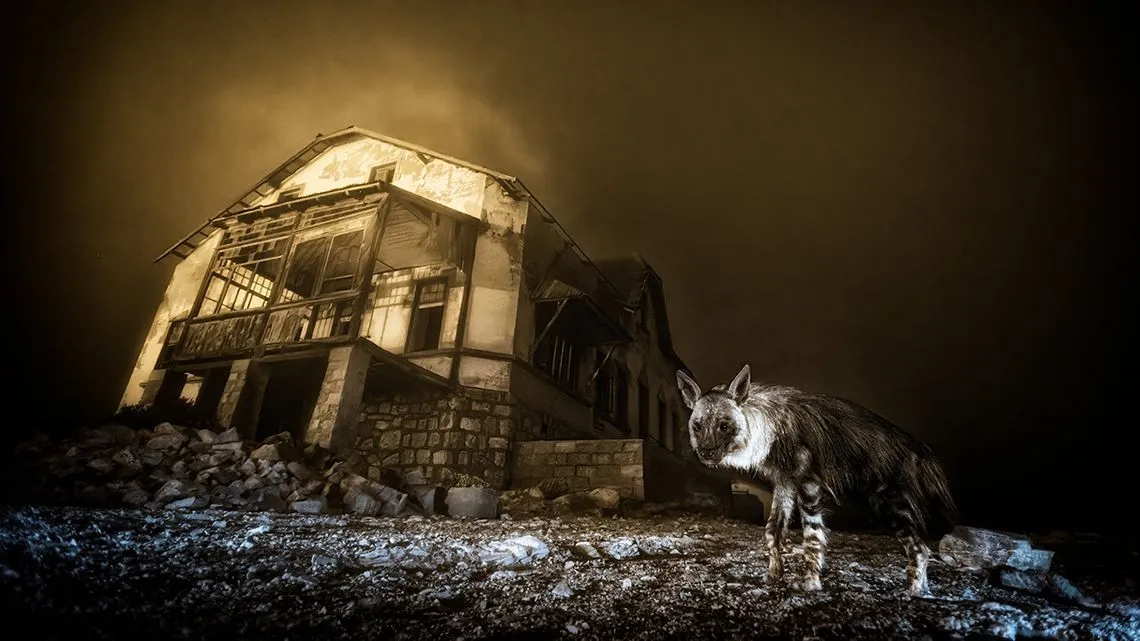South African photographer Wim van den Heever has received this year’s Wildlife Photographer of the Year award for his image of a brown hyena outside a ruined diamond mining town.
A haunting photograph of a brown hyena (Parahyaena brunnea) wandering through the sand-filled ruins of an abandoned diamond-mining settlement in Namibia has won this year’s Wildlife Photographer of the Year title.
The striking image, titled “Ghost Town Visitor,” captures the world’s rarest hyena illuminated by soft, otherworldly light in the deserted town of Kolmanskop. Photographer Wim Van den Heever spent nearly a decade pursuing this moment, setting up camera traps after discovering hyena tracks there years earlier.
“I tried for several seasons to photograph them at dawn and dusk from nearby buildings, but I never managed it,” Van den Heever told Live Science via email. “Eventually, I switched to camera traps, carefully positioning them in places hyenas were likely to pass. After almost ten years of patience, I finally captured the shot — a brown hyena gliding silently through the ghostly ruins.”
Known locally as strandwolves, brown hyenas are distinguished by their long, shaggy coats, pointed ears, and distinctive manes. With an estimated global population of fewer than 4,000 individuals, they are primarily found in the dry landscapes of Namibia, Botswana, and South Africa.
Competition organizers explained that hyenas are known to roam through Kolmanskop while searching for Cape fur seal pups or scavenging carrion along the Namib Desert coast.
“For years, I’d noticed tracks and droppings scattered through Kolmanskop’s eerie, sand-choked streets,” Van den Heever said. “Capturing one moving through this abandoned world became a dream of mine.”
The image also earned first place in the Urban Wildlife category. “You get a tingling sense of presence just looking at it — this is clearly the hyena’s realm,” said Kathy Moran, Chair of the Wildlife Photographer of the Year jury. “I also love how it redefines ‘urban.’ It once was a human space, but no longer.”
Now in its 61st year, the Wildlife Photographer of the Year competition — organized by the Natural History Museum in London — received a record 60,636 entries from 113 countries and territories, marking its most competitive year yet.
Among the standout winners:
- Qingrong Yang (China) claimed top honors in the Birds category with a precisely timed shot of a ladyfish (Elops saurus) snatching prey from beneath a little egret (Egretta garzetta) at Yundang Lake — once a polluted harbor, now restored to ecological health through a major engineering project.
- In the Mammal Behavior category, Dennis Stogsdill (USA) captured an extraordinary moment in Tanzania’s Serengeti National Park — a caracal (Caracal caracal) hunting a lesser flamingo (Phoeniconaias minor). “It was sheer luck,” Stogsdill said. “We were expecting a serval, but suddenly a caracal appeared and began stalking the flamingos. Seeing one hunt in broad daylight is incredibly rare.”
Other memorable images included:
- A gum-leaf skeletoniser caterpillar (Uraba lugens), humorously nicknamed the “Mad Hatterpillar,” balancing a tower of shed exoskeletons on its head (by Georgina Steytler, Australia).
- Hundreds of western diamondback rattlesnakes (Crotalus atrox) coiled together at a controversial annual round-up in Sweetwater, Texas (by Javier Aznar González de Rueda, Spain).
- A delicate orb weaver spider (family Araneidae) resting in its silken shelter on a cool September morning (by Jamie Smart, UK).
Each photograph, in its own way, captures the fragile intersection of wildlife, human impact, and the beauty of persistence — whether in the ghostly sands of Kolmanskop or the bustling ecosystems reborn from neglect.
